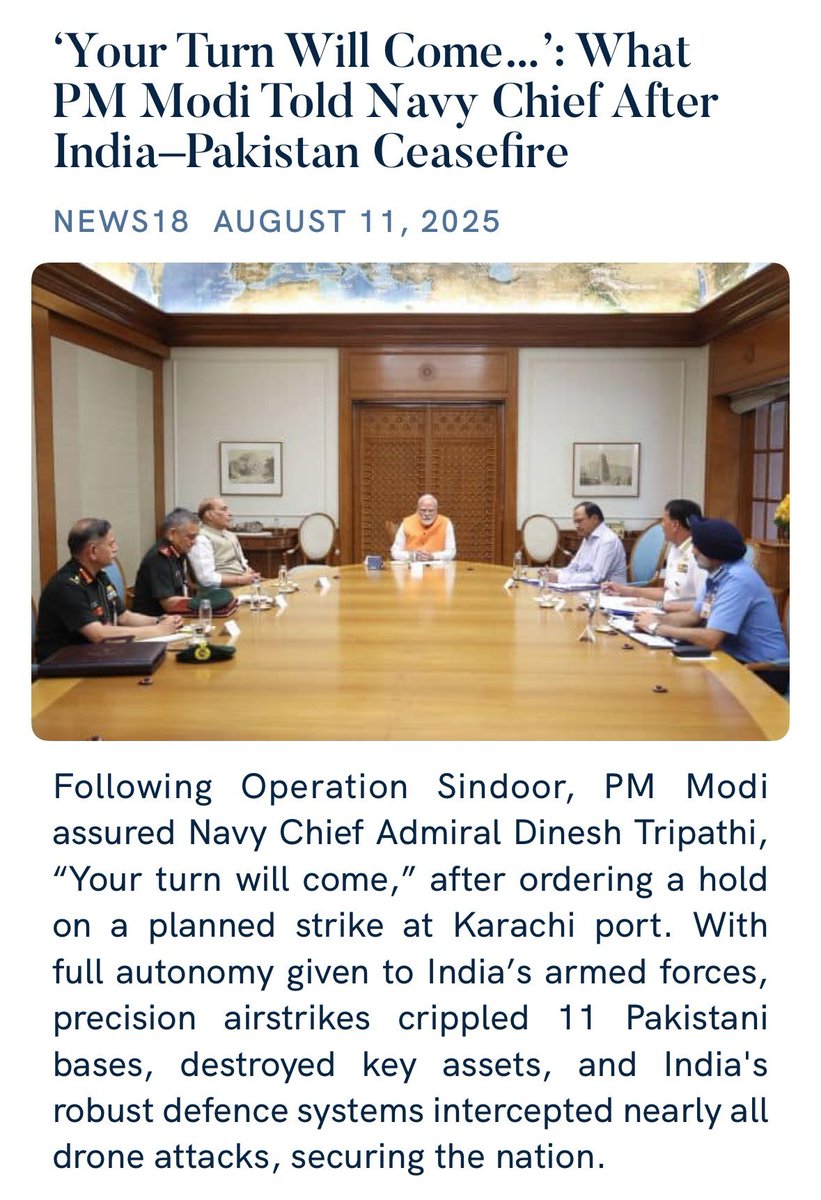Ok folks, carrying on from this thread on J&K history quoted below, let me now share some thoughts about the legal status of Jammu and Kashmir as it stands today.
https://twitter.com/CestMoiz/status/1309849730118189057
In spite of successive Indian Governments’ insistence that the whole of Jammu and Kashmir has been integral part of India since the signing of Instrument of Accession, doubts have been raised by many on its legality.
This is due to deliberately created false narratives by Pakistan and other inimical elements, which has cluttered the issue. This thread will attempt to de-clutter the same and bring out the fact that the whole region indeed belongs to India without a shadow of doubt. 
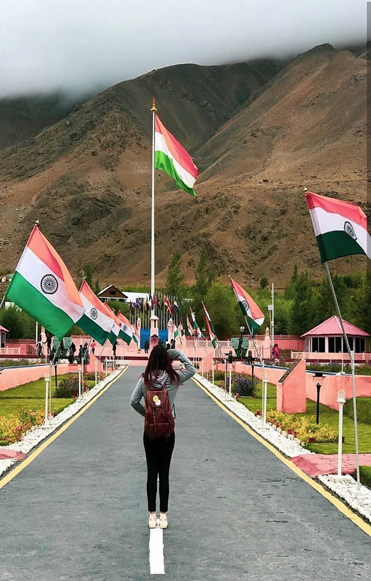
The Indian government’s stated position concerning the Status of J&K is:
“The Accession of the State of Jammu and Kashmir to India, signed by the Maharaja [erstwhile ruler of the State] on October 26, 1947, was completely valid under the Government of India Act [1935] and ..
“The Accession of the State of Jammu and Kashmir to India, signed by the Maharaja [erstwhile ruler of the State] on October 26, 1947, was completely valid under the Government of India Act [1935] and ..
.. international law and was total and irrevocable. The Accession was also supported by the largest political party in the State, the National Conference. In the Indian Independence Act, there was no provision for any conditional accession.”
Unquote
Unquote
The tweets that follow will examine these facets of this statement above - 'Completely Valid', 'Total and Irrevocable' and 'No Provision for any Conditional Accession'.
The previous thread (linked in the first tweet) had brought out how the predecessors of Raja Hari Singh had brought the region of Jammu & Kashmir under their rule. The Kingdom included the territories of Chitral, Hunza, Gilgit and Baltistan along with the south western districts. 
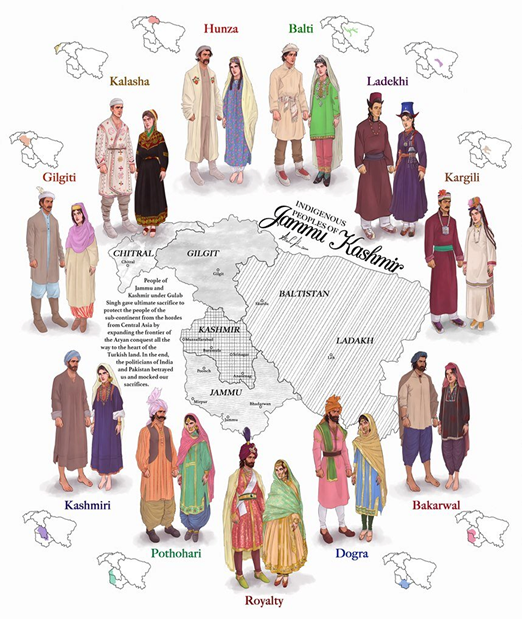
One of the many myths that Pakistan has propagated is that because India was partitioned on the basis of 'Two Nation Theory', and Kashmir being a Muslim majority state, therefore it should have been a part of Pakistan.
It's time to bust this bubble for good.
It's time to bust this bubble for good.
Jinnah himself had clarified his stand earlier in an interview held on 17 June 1947. He said : "After the lapse of paramountcy the Indian States would be constitutionally and legally sovereign States and free to adopt for themselves any course they wished.
It is open to the States to join Hindustan, Pakistan or to decide to remain independent".
Unquote
The same aspect was re-iterated by the last Viceroy to India, Lord Mountbatten, in his speech to Chamber of Princes made on 25 June 1947.
Unquote
The same aspect was re-iterated by the last Viceroy to India, Lord Mountbatten, in his speech to Chamber of Princes made on 25 June 1947.
Mountbatten said : "...... The Indian Independence Act releases the Princely States from all their obligations to the Crown. The States will have complete freedom - technically and legally, once they become independent".
Unquote
Unquote
These quotations from two most important leaders of the time imply that after the lapse of Paramountcy, all the Princely States which did not accede to either India or Pakistan, became Independent Sovereign States.
Thus, when Maharaja Hari Singh did not accede to both the countries, he became the ruler of a sovereign State of J&K with all the territory as depicted on the map below!
Once again, do note Chitral in this map. I'll talk about Chitral after some time.
Once again, do note Chitral in this map. I'll talk about Chitral after some time.
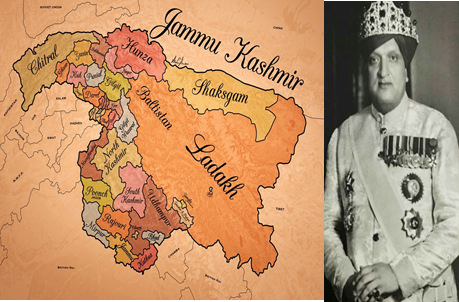
Let us now examine the Government of India Act 1935, under which the Accession of Princely States, including J&K, was legalised.
This Act was passed by British Parliament in August 1935. It proposed an all India federation which included those princely states who might accede to the Indian Federation VOLUNTARILY.
Section 6, Sub-para1 of the act laid down the following procedure for accession of the Princely States to the Union of India :
FIRSTLY The ruler of the Princely State should sign an Instrument of Accession;
SECONDLY the Instrument must contain the ruler’s obligations and the ..
FIRSTLY The ruler of the Princely State should sign an Instrument of Accession;
SECONDLY the Instrument must contain the ruler’s obligations and the ..
.. applicability of the rules and laws of the Dominion over the state;
FINALLY, The Instrument of Accession must be formally “accepted” by the Governor-General.
FINALLY, The Instrument of Accession must be formally “accepted” by the Governor-General.
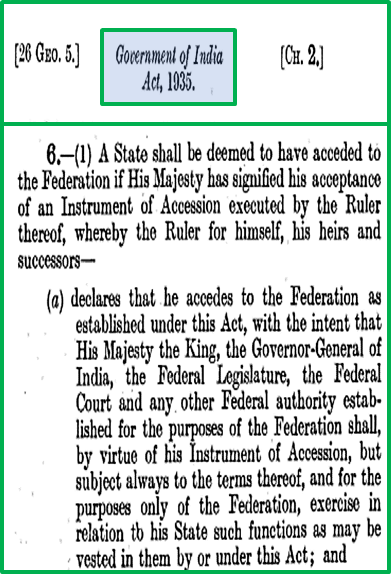
Further, the Indian Independence Act of 1947, empowered the Governor General to adapt and modify the provisions of the Government of India Act, 1935, while applying the provisions to the Accession of Princely States post-independence.
It must be borne in mind that neither of the acts provided for ‘conditional accession’ or plebiscite, which means that once the accession is signed by the ruler and accepted by the Governor General, it was TOTAL and IRREVOCABLE.
By signing on this legal document, the Instrument of Accession, Hari Singh, the Maharaja of Jammu and Kashmir, agreed that the State would become a part of India on October 26, 1947.
Therefore, there is no denying the fact that his action of acceding to India, whether under ..

Therefore, there is no denying the fact that his action of acceding to India, whether under ..
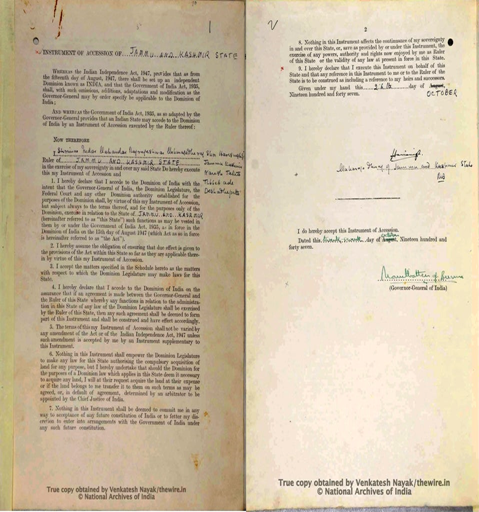
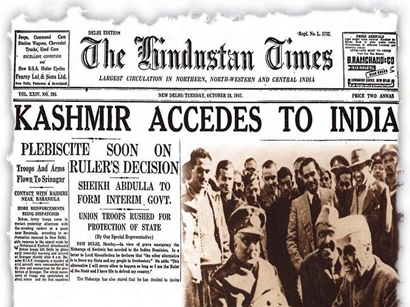
duress or otherwise, holds legal validity.
So, if there was no provision for conditional accession in the act, where did this idea of plebiscite arise?
Interestingly, this Red Herring appears for the first time in a letter sent by Lord Mountbatten to Raja Hari Singh!
Interestingly, this Red Herring appears for the first time in a letter sent by Lord Mountbatten to Raja Hari Singh!
Mountbatten wrote on 27 October, a day after the accession: “It is my Government’s wish that as soon as law and order have been restored in Kashmir and her soil cleared of the invader, the question of the State’s accession should be settled by a reference to the people.”
Unquote.
Unquote.
The British games had started quite early, I must say!
Or perhaps it might be that they had fully expected to see Srinagar fall to the 'raiders' who instead, stopped by for rape and plunder in Baramula, thereby prompting the Maharaja to formally accede to India and the Indian Army landing in Srinagar just in time to save the Valley?
^^
Here is another, different thread of mine chronicling the epic military campaign that followed. Do go through it in case you have some time to spare
Here is another, different thread of mine chronicling the epic military campaign that followed. Do go through it in case you have some time to spare
https://twitter.com/CestMoiz/status/1187750780578816003
The UN Security Council Resolution-47 of August 1948 too, uncannily echoes Mountbatten’s solution. In its resolution, the UN had proposed a three-step process, the first step being removal of ALL Pakistani troops and tribal invaders from the State.
After this, India was also to withdraw the bulk of its forces, keeping just enough to ensure law and order.
Once this happened, a "free and fair" plebiscite was to be held to allow the Kashmiri people to decide their future.
Once this happened, a "free and fair" plebiscite was to be held to allow the Kashmiri people to decide their future.
For all their bluster and hyperbole about 'implementing' the UN Resolution, I wonder if Pakistan would ever be able to fulfill just the first step proposed in the same, in case someone goes on and calls their bluff!
The point to note here is that there was no debate in UN over the ‘legality’ of accession of the J&K State, but only on determining the will of the people. The same is reflected in the fact that India was to keep its troops in J&K for maintaining law and order whereas Pakistan ..
.. was to withdraw ALL its forces and people.
Contrary to another myth created by Pakistan that India does not want a plebiscite, it is a fact that Pakistan itself was unsure of the outcome of the referendum in the early days and hence was stalling the conduct of plebiscite.
Contrary to another myth created by Pakistan that India does not want a plebiscite, it is a fact that Pakistan itself was unsure of the outcome of the referendum in the early days and hence was stalling the conduct of plebiscite.
Pakistan’s marauding tribal forces had alienated the local populace by looting and raping while they advanced to Srinagar in the 1947 invasion. If a referendum were to be held at that time, these atrocities would have been fresh in the minds of the local populace, who possibly ..
.. would have voted for acceding to India.
Secondly, the Pakistanis were aware that Sheikh Abdullah, who was the popular regional leader at that time was closer to India.
Secondly, the Pakistanis were aware that Sheikh Abdullah, who was the popular regional leader at that time was closer to India.
Notwithstanding, India still waited for several years for Pakistan to fulfil the pre-conditions for a plebiscite, the first step for which was the withdrawal of all its troops and tribals.
Meanwhile, the Indian Govt continued its efforts to integrate the State of J&K into India. Towards this, Article 370, reflecting the terms of Instrument of Accession, was included in the Indian Constitution.
When the mandated withdrawal of her troops and citizens by Pakistan did not occur for several years, elections were held from Aug-Sep 1951 and a Constituent Assembly was formed. The main objectives given to the Constituent Assembly was to frame the Constitution of J&K and to ..
.. give a ‘reasoned conclusion regarding accession’.
The Constituent Assembly of Jammu and Kashmir ratified the accession of the State to India and adopted a new Constitution on 26 Jan 1957 which reaffirmed that ‘the State is and shall be an integral part of the Union of India’.
The Constituent Assembly of Jammu and Kashmir ratified the accession of the State to India and adopted a new Constitution on 26 Jan 1957 which reaffirmed that ‘the State is and shall be an integral part of the Union of India’.
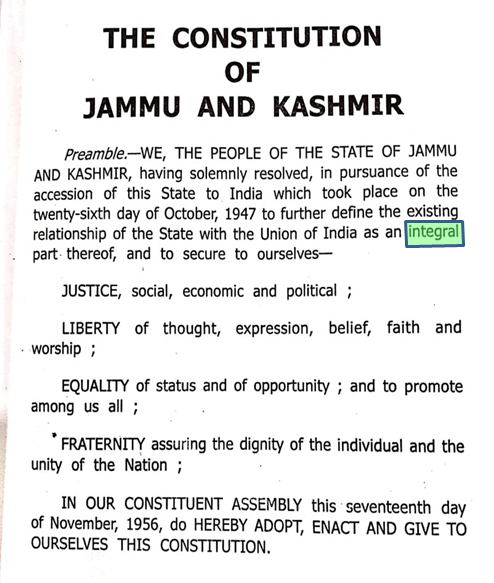
Interestingly, while the Indian Constitution always had a reference to J&K being its integral part, the Pakistani constitution does not find a mention for the occupied territories of the State that they control - basically the PoK and Gilgit-Baltistan.
As highlighted in blue on the graphic below, the Pakistani Constitution talks about a future date when the people of Jammu and Kashmir may decide to accede to it but there is no recognition to Gilgit-Baltistan and PoJK currently under illegal Pakistani occupation. 
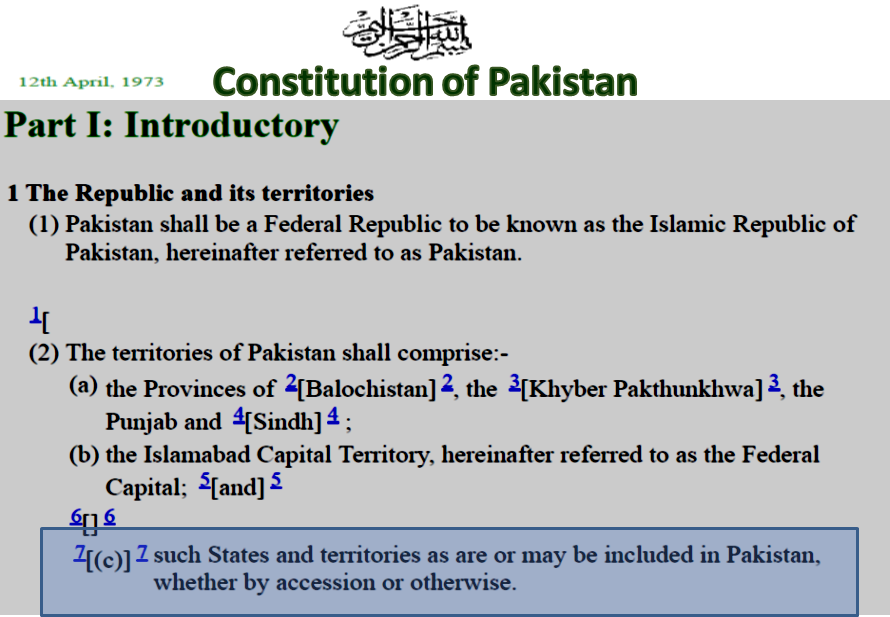
Thus, the Govt of Pakistan or its judiciary has no legal or constitutional locus-standi on territories that have been illegally and forcibly occupied by it!
The Security Council tried to resolve the issue by appointing a series of individual representatives empowered to mediate between India and Pakistan.
Three of them were - Gen McNaughton, Sir Owen Dixon and Frank Porter
Three of them were - Gen McNaughton, Sir Owen Dixon and Frank Porter

But by 1958, the UN realised the futility of its efforts and deliberately did not appoint a representative, effectively reducing its importance.
Indeed, during both the 1965 and 1971 India-Pakistan wars, the Security Council only passed resolutions demanding a ceasefire between the two sides, making no reference to the people of Kashmir or the right to self-determination.
And then came the Simla Agreement!
And then came the Simla Agreement!
After the Shimla agreement of 1972, both countries agreed that no third-party mediation was welcome and India and Pakistan were bound to solve all bilateral issues by dialogue. 

In fact, after India revoked Article 370, Pak envoy to the UN Maleeha Lodhi asked the UN Secretary General to "play his due role" following India's decision.
In reply, the UN Chief made a reference to the Shimla Agreement and stated that a third-party mediation was not possible!

In reply, the UN Chief made a reference to the Shimla Agreement and stated that a third-party mediation was not possible!

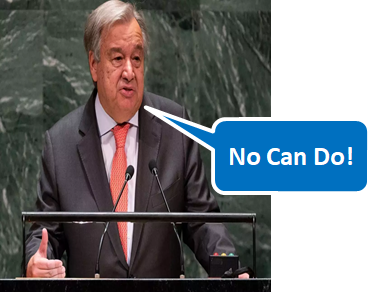
I do hope that by now I have been able to somewhat clarify about the whys and hows of India’s stated stand on J&K and the reason for the Instrument of Accession being total and irrevocable.
It is about time for the Pakistani myths about the accession to be dispelled. Let there be no lingering doubts in saying that J&K is indeed an integral part of India, PoK, Gilgit-Baltistan AND Aksai Chin included. 
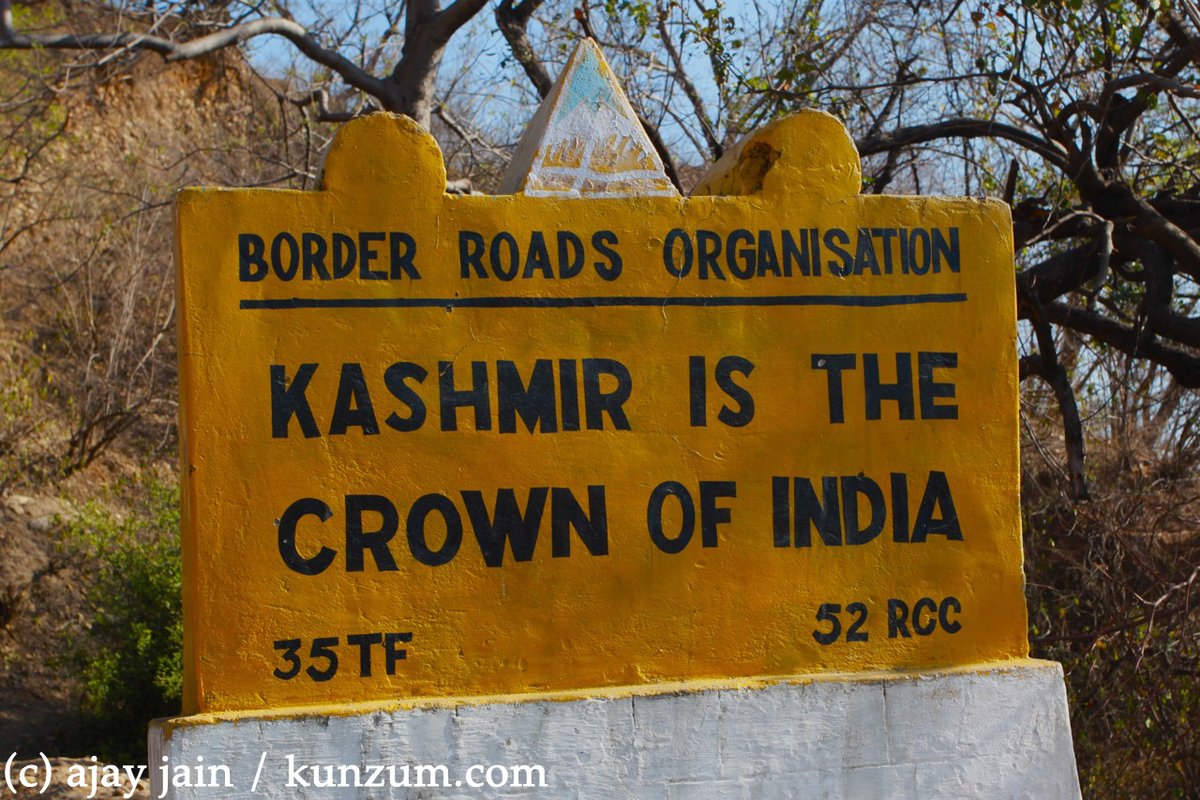
In the end, I'll just leave this tweet here, regarding an additional territory under the suzerainty of the Maharaja of Kashmir as on 26 Oct 1947.
:Fin:
:Fin:
https://twitter.com/CestMoiz/status/1309905482379857920
• • •
Missing some Tweet in this thread? You can try to
force a refresh


